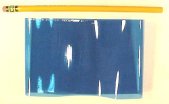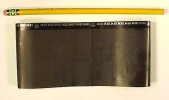Old Recordings Discs Tapes Wires Dictation Belts Other Media
| Dictaphone belts replaced the dictation cylinder during the 1940s.
Sound was embossed by a needle onto a loop of acetate-type soft-surface
material that looks like film. Similar but usually incompatible systems
seem to have been used by the government somewhat earlier.
During the late 1950s, the same design was used with sheets of magnetic film which looks like a wide loop of audio tape. A recording head was substituted for the embossing needle. Dictaphone was joined in this marketplace by IBM and Peirce, each offering non-compatible products. IBM also made them in two sizes, some of which won't work on other machines in its line. These products phase out as the cassette enters.


The translucent embossed belts stiffen as they age and should be made softer before being copied so they can track better. Some are of a slightly smaller diameter and will split if forced onto the wrong mandrel. BASIC COSTS: Perfect belts cost $ 50 to master to hard disc. I seldom encounter perfect belts. ADDITIONAL SERVICES: REPAIRS: The most common problem, affecting about 90% of those I've worked on, is that the embossing needle or magnetic recording tape head usually shifts slightly during the start-stop process when they were first recorded. Adjusting for the problems these introduce requires a rehearsal with the tracking adjustment control before copying. This adds about $ 50 per belt. Though belts seem to shrink as they age, the feed screw driving the playback head is not adjustible. I usually have to stop recording, make adjustments, then start again, then edit the segments together. Noises louder than the desired signal are usually present each time the machine was started and stoped. I remove most of these bangs by hand editing. Belts cost $ 150- 200 each to make a reasonable- sounding listening copy. Occassionally belts were stapled to the letters produced from them and/or were squeezed flat in file drawers, creasing them and creating a thump during playback which cannot always be removed. The creases have to be softened before they can be put onto the playback machine; if not, the belt splits and may be unrepairable. Suppelizing them is an additional step- about $ 35. This takes about a week per belt. It was common for them to have identifying characters written on the recorded surface with a china pencil. The marks theis leave turns stiff and dry with age and will crunch each revolution. I remove this as part of the preparation and cleaing process and copy the data to the belt's inner side. Four to five belts fit on a CD or cassette at $ 30 for the first one, $ 20 for each additional.
This site ©2001 Steven Smolian. rev. 1 |
